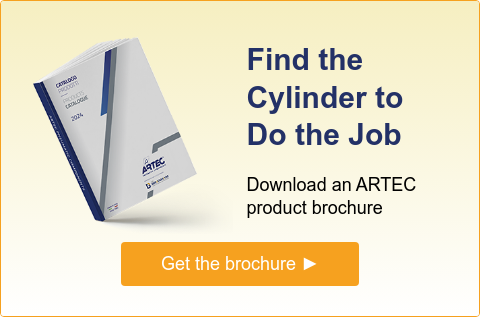
W.C. Branham products are designed and manufactured with the highest quality materials and workmanship. We use proprietary quality techniques that are based on countless hours of testing. And re-testing.
Nonetheless, wear and tear is inevitable. Pneumatic cylinders used in industrial applications or in heavy machinery, for instance, often face extremely demanding working conditions. They are constantly moving, often fast and under tremendous force.
Common Signs Your Pneumatic Actuator Needs to be Repaired
Contamination and inadequate lubrication are two of the leading causes of pneumatic actuator breakdown. And operating outside of the specified pressure range can damage seals and/or rods.
Issues can vary depending on the type of pneumatic actuator and application, but there are some common signs you may see that indicate the need for cylinder repair:
- Failure to move (or actuate). Lack of movement is a clear sign that something is wrong. Monitoring actuating pressure can help avoid system breakdown.
- Actuating too slowly.
- Requiring higher than normal pressure to actuate. If pilot control pressure is too low, the control line may be too small or the metering choke valve could be malfunctioning. Also, there may be mechanical binding between the working load and the air cylinder, so check to make sure that the parallelism is maintained.
- Visual corrosion or excessive wear.
- Hissing noises.
- Load pulsing. Air cylinders are known for their smooth, almost silent movement. If you notice a change, it’s probably not running right.
- Intermittent start-up. When actuators run at overload capacity, seals are subjected to higher stress and friction rates. Rod ends bend or break, and actuators can come apart. In a system with speed control or energy-absorbing devices, pressure spikes can also occur above normal system pressures.
- Elongated or stretched cylinder. For cable cylinders.
Sometimes, Cylinder Repair is an Easy Fix
Sometimes, a repair will require you to disassemble and reassemble your air cylinder, but repairing or replacing components instead of getting a whole new cylinder can keep downtime to a minimum and prolong the life of a cylinder. That gives you the best return on your investment.
For this reason, W.C. Branham offers repair kits for many of our rodless cylinders, including our cable cylinders, PNEU-SA rodless pneumatic cylinders, DURATRK cylinders, and MAGTEC rodless cylinders. We recommend you have a kit on hand for each type of cylinder you’re using, so you can make repairs as quickly as possible.
Always make sure the power supply is off and any leftover air has been released before beginning your pneumatic cylinder repair. This is a critical safety issue. Inspect the cylinder, tube, and rod seal–these are the most vulnerable components. Replace seals or make other repairs as soon as you detect damage.
Lubricate the following components, as necessary:
- Piston outer surface and rod surface
- Piston seal groove, plus the inner and outer surface
- Rod seal
- Rod seal groove on the rod cover
- Tube gaskets
- Tube inner surface
When You Should Replace Your Cylinders
If you find extensive damage to your pneumatic cylinder, it’s probably time to replace the unit instead of trying to repair it. However, if you’re having repeat problems, you may be using the wrong pneumatic cylinder altogether.
Before you replace your failing cylinder with the same product, consider a customized design. Pneumatic cylinders can be customized, and a custom-designed cylinder could give you the best performance. We can help you troubleshoot and determine the best, most cost-effective, long-term fix.
How to Prevent Your Pneumatic Cylinders From Needing a Repair or Replacement
To ensure your equipment performs optimally, here are some tips to extend the life of your cylinders:
- One thing you should get in the habit of doing is regularly inspecting and maintaining your pneumatic cylinders. There are times when something just breaks or goes askew, but most often, repairs become necessary due to wear and tear. Cylinders that receive regular attention perform the best and last the longest.
- Clean external parts, so you can see if there is any leakage or damage to seals. If there is, make repairs or replace the seals right away.
- The most at-risk components are the cylinder itself plus the rod (for rod cylinders), cable seal, and tube. For this reason you should always be routinely inspecting these parts. For cable cylinders, be sure to inspect the nylon-jacket around the cable O.D. Be sure that the nylon coating is free of marks or nicks that may wear out the main seal. Use emery cloth to buff out minor damage. If severe, a replacement cable assembly is required.
- Try ISO cylinders, which follow specific international quality standards and can make for shorter downtime when procuring a replacement.
- Check to be sure all of these components have adequate lubrication (touch it up, if necessary):
- For rod cylinders, the rod seal, plus the rod’s inner and outer surface including the rod seal groove
- For cable cylinders, the cable seal gland
- Tube gaskets and inner surface
- Piston seal groove and the inner and outer surface
- Piston inner and outer surface
- Proper tensioning is critical to performance and service life, especially with cable cylinders. Inspect to make sure there is not too much slack, but also that the cables are not too tight so as to prohibit movement.
We get it, things happen and sometimes repairs are inevitable. That’s part of life when you’re working with any type of equipment. Pneumatic cylinders used in industrial applications operate in high-stress environments, so it's likely they will need repairs at some point—even if they are built to last.


